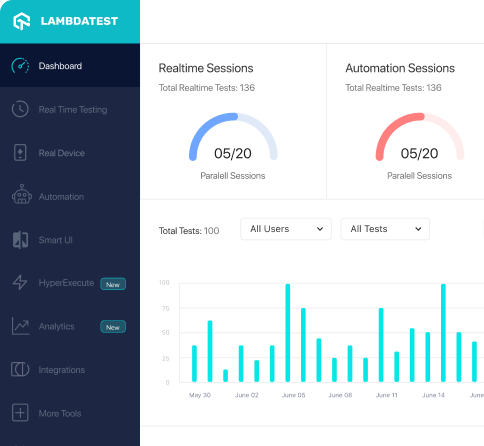How to use XMLValidationMatcherIT class of com.consol.citrus.validation package
Best Citrus code snippet using com.consol.citrus.validation.XMLValidationMatcherIT
Source: XMLValidationMatcherIT.java
...20/**21 * @author Christoph Deppisch22 * @since 200823 */24public class XMLValidationMatcherIT extends AbstractTestNGCitrusTest {25 @Test26 @CitrusXmlTest27 public void XMLValidationMatcherIT() {}28}...XMLValidationMatcherIT
Using AI Code Generation
1import com.consol.citrus.dsl.junit.JUnit4CitrusTestDesigner;2import com.consol.citrus.dsl.testng.TestNGCitrusTestDesigner;3import com.consol.citrus.validation.xml.XMLValidationMatcher;4import org.testng.annotations.Test;5public class XMLValidationMatcherIT extends TestNGCitrusTestDesigner {6 public void xmlValidationMatcher() {7 variable("controlMessage", controlMessage);8 variable("testMessage", testMessage);9 variable("controlMessage", controlMessage);10 variable("testMessage", testMessage);11 description("XML validation matcher test");12 echo("Validate XML message");13 $(XMLValidationMatcher.validateXML()14 .controlMessage("${controlMessage}")15 .testMessage("${testMessage}")16 .ignoreWhitespace()17 .ignoreComments()18 .ignoreXPath("/TestMessage/MessageHeader/MessageId")19 .ignoreXPath("/TestMessage/MessageHeader/MessagXMLValidationMatcherIT
Using AI Code Generation
1package com.consol.citrus.validation;2import org.testng.Assert;3import org.testng.annotations.Test;4public class XMLValidationMatcherIT {5 public void testXMLValidationMatcher() {6 XMLValidationMatcher matcher = new XMLValidationMatcher();7 matcher.setIgnoreWhitespace(true);8 matcher.setIgnoreComments(true);9 matcher.setIgnoreNamespaces(true);10 matcher.setIgnoreAttributes(new String[]{"id"});11 matcher.setIgnoreElements(new String[]{"date"});12 matcher.setIgnoreDtd(true);13 }14}15package com.consol.citrus.validation;16import org.testng.Assert;17import org.testng.annotations.Test;18public class XMLValidationMatcherIT {19 public void testXMLValidationMatcher() {20 XMLValidationMatcher matcher = new XMLValidationMatcher();21 matcher.setIgnoreWhitespace(true);22 matcher.setIgnoreComments(true);23 matcher.setIgnoreNamespaces(true);24 matcher.setIgnoreAttributes(new String[]{"id"});25 matcher.setIgnoreElements(new String[]{"date"});XMLValidationMatcherIT
Using AI Code Generation
1xmlValidationMatcherIT() {2}3package com.consol.citrus.validation;4import com.consol.citrus.context.TestContext;5import com.consol.citrus.exceptions.ValidationException;6import com.consol.citrus.validation.matcher.ValidationMatcher;7import org.springframework.util.xml.DomUtils;8import org.w3c.dom.Document;9import org.w3c.dom.Element;10import org.xmlunit.builder.DiffBuilder;11import org.xmlunit.builder.Input;12import org.xmlunit.diff.Diff;13import org.xmlunit.diff.Difference;14import javax.xml.parsers.DocumentBuilderFactory;15import java.io.StringReader;16import java.util.ArrayList;17import java.util.List;18public class XMLValidationMatcherIT implements ValidationMatcher<Document> {19 public List<String> validate(String fieldName, Document control, Document value, TestContext context) {20 List<String> errors = new ArrayList<>();21 try {22 Element timestamp = DomUtils.getChildElementByTagName(control.getDocumentElement(), "timestamp");23 timestamp.getParentNode().removeChild(timestamp);24 Element timestamp1 = DomUtils.getChildElementByTagName(value.getDocumentElement(), "timestamp");25 timestamp1.getParentNode().removeChild(timestamp1);26 Diff diff = DiffBuilder.compare(Input.fromDocument(control))27 .withTest(Input.fromDocument(value))28 .checkForSimilar()29 .ignoreComments()30 .ignoreWhitespace()31 .build();32 if (diff.hasDifferences()) {33 for (Difference difference : diff.getDifferences()) {34 errors.add(difference.getDescription());35 }36 }37 } catch (Exception e) {38 throw new ValidationException("Error while validating XML documents", e);39 }40 return errors;41 }42 public boolean supports(Class<?> type) {43 return Document.class.isAssignableFrom(type);44 }Automation Testing Tutorials
Learn to execute automation testing from scratch with LambdaTest Learning Hub. Right from setting up the prerequisites to run your first automation test, to following best practices and diving deeper into advanced test scenarios. LambdaTest Learning Hubs compile a list of step-by-step guides to help you be proficient with different test automation frameworks i.e. Selenium, Cypress, TestNG etc.
LambdaTest Learning Hubs:
- JUnit Tutorial
- TestNG Tutorial
- Webdriver Tutorial
- WebDriverIO Tutorial
- Protractor Tutorial
- Selenium 4 Tutorial
- Jenkins Tutorial
- NUnit Tutorial
- Jest Tutorial
- Playwright Tutorial
- Cypress Tutorial
- PyTest Tutorial
YouTube
You could also refer to video tutorials over LambdaTest YouTube channel to get step by step demonstration from industry experts.
Most used methods in XMLValidationMatcherIT
Try LambdaTest Now !!
Get 100 minutes of automation test minutes FREE!!



